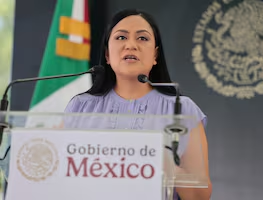Más Información

INE aprueba ampliación presupuestal de 9.2 mdp; se destinará para comprar chalecos en elecciones del Poder Judicial

Sheinbaum anuncia obras de infraestructura en Nayarit; destaca puente que irá de Bahía de Banderas a Puerto Vallarta y un acueducto

Detienen a presunto jefe de célula delictiva allegada a Los Chapitos; se encargaba de narcomenudeo y compra-venta de armamento

“¡Arráncate, Coalcomán!”; así fue la campaña de Anavel Ávila, presuntamente ligada al “Mencho”, para Movimiento Ciudadano

Presupuesto para programas sociales está asegurado en la Constitución: Ariadna Montiel; destaca que se benefician a 320 mil nayaritas

Sheinbaum anuncia construcción de Farmacias del Bienestar en 2025; asegura habrá medicamentos gratuitos para personas vulnerables
The number of people applying for asylum in Mexico has soared by more than 150 percent since Donald Trump was elected U.S. president, according to Mexican data, as more Central American migrants seek to stay rather than take their chances in the United States.
Between November 2016 and March, Mexico's National Commission for Refugee Assistance (COMAR) received 5,421 asylum applications, up from 2,148 over the same period in 2015 and 2016.
The number of detentions along the southwestern U.S. border has fallen about 4 percent over the same five-month period, as Trump's tough immigration proposals sent a chill through migrant communities. Just like the vast majority of Mexico's asylum applicants, many of those detained on the U.S. border come from the violent countries of Honduras, Guatemala and El Salvador.
Trump won the Nov. 8 election after vowing to crack down on illegal immigration by deporting millions and building a wall on the U.S.-Mexico border, measures Central American migrants say have scared them into putting their travel plans on ice.
Although experts say it is too early to tell whether the rise in asylum applications is undoubtedly Trump-related, the data suggests more of those migrants are now trying to stay in Mexico.
"The views that people have about a political change, they definitely impact everyone's consciousness," said Cinthia Perez, a director at COMAR.
According to U.S. Department of Homeland Security data, the number of Central American parents and children stopped at the U.S.-Mexico border has dropped steadily since Trump's election victory, to just over 1,000 in March, a 93 percent fall from December.
Perez said it was not yet fully clear whether the Trump factor was contributing to a rise in asylum applications that stretches back several years. But she said it was a possibility the agency would need to study further by asking applicants more Trump-focused questions.
Perez added that COMAR's work with the United Nations High Commissioner for Refugees (UNHCR) and other civil society groups in identifying the types of people who could be eligible for asylum had also helped drive up the numbers.
The UNHCR's spokeswoman in Mexico, Francesca Fontanini, said better conditions for Central American migrants arriving in the country, coupled with efforts to reunify families, were also contributing to the jump in the numbers of applicants.
Asylum applications have been rising steadily in recent years, with 8,781 applicants in 2016, up from just under 3,500 in 2015. COMAR predicts it could receive over 22,500 asylum applications in 2017, and Perez said she did not believe Trump's arrival at the White House had significantly altered that estimate.
bg




